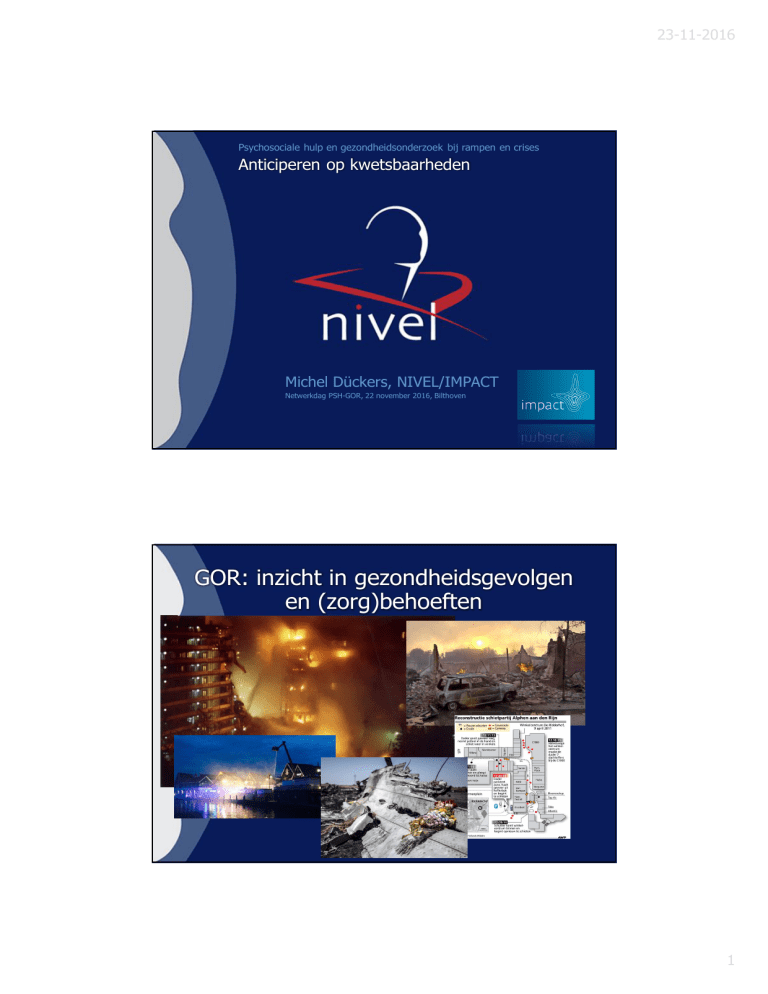
23-11-2016
Psychosociale hulp en gezondheidsonderzoek bij rampen en crises
Anticiperen op kwetsbaarheden
Michel Dückers, NIVEL/IMPACT
Netwerkdag PSH-GOR, 22 november 2016, Bilthoven
GOR: inzicht in gezondheidsgevolgen
en (zorg)behoeften
1
23-11-2016
PSH: ondersteuning en zorg gericht op
gezondheid, welbevinden en veiligheid
Het verhaal begint met gezondheid
2
23-11-2016
Blootstelling bedreigt gezondheid
Allerlei factoren zijn van invloed
3
23-11-2016
En daar moeten we iets mee: PSH
• Basishulp
• Informatie
• Sociale en emotionele
steun
• Praktische
ondersteuning
• Passende
gezondheidszorg waar
nodig
Psychosocial
support
Maar via welke route?
4
23-11-2016
PSH: terechte kritiekpunten
Focus op psychopathologie (m.n. PTSS) is te
smal
Discutabele werkzaamheid maatregelen/perverse
effecten vroegtijdige interventies:
Preventie
Screening
Psycho-educatie
Psychologische debriefing
Stigma “slachtoffer” of “patiënt”
Verleiding tot disproportionaliteit, ongelijke
bevoordeling, pamperen, betuttelen
Blootstelling nodigt uit tot attributie
PSH: fasen in denken
Hegel: “werkelijkheid is continu
proces” “dialectiek”
these antithese synthese
Ook psychosociale hulp bij
rampen ontkomt hier niet aan
Dückers MLA, Thormar SB. Post-disaster psychosocial support and quality improvement: A conceptual framework for
understanding and improving the quality of psychosocial support programs. Nursing & Health Sciences 2015; 17 (2),
159-165.
5
23-11-2016
Combineer PSH met GOR
GOR
“Bij kleinschalige incidenten en
zedenzaken met een grote
maatschappelijke impact kan
gezondheidsonderzoek worden
gebruikt in combinatie met het proces
PSH om inzicht te krijgen in de
psychische gezondheid en behoeften
van getroffenen. Ook bij sociale en/of
maatschappelijke onrust kan dit aan
de orde zijn. Daarnaast kan GOR
worden ingezet bij crises rond
voedselveiligheid, grote
transportongevallen of
natuurrampen.”
~ Handreiking GOR, 2014
PSH
Combi
Kwetsbaarheid
Vatbaarheid
Gebrek aan capaciteiten om
blootstelling op te vangen
Gebrek aan capaciteiten
voor herstel
6
23-11-2016
Capaciteiten en schaalniveaus
Kwetsbaarheid
van landen
7
23-11-2016
Prevalentie van PTSS
Lifetime prevalence in 24 landen (N = 86.687)
Dückers MLA, Alisic E, Brewin CR. A vulnerability paradox in the cross-national prevalence of post-traumatic stress
disorder. British Journal of Psychiatry 2016. 209 (4), 300-305.
Kwetsbaarheidsparadox
Lifetime PTSS geschat in vier modellen
Dückers MLA, Alisic E, Brewin CR. A vulnerability paradox in the cross-national prevalence of post-traumatic stress
disorder. British Journal of Psychiatry 2016. 209 (4), 300-305.
8
23-11-2016
Kwetsbaarheidsparadox
Lifetime PTSS geschat in vier modellen
Dückers MLA, Alisic E, Brewin CR. A vulnerability paradox in the cross-national prevalence of post-traumatic stress
disorder. British Journal of Psychiatry 2016. 209 (4), 300-305.
Kwetsbaarheidsparadox
16 landen in vier groepen
High
exposure
(> 67.14)
Low
exposure
(< 67.14)
High vulnerability
Low vulnerability
(> 36.23)
(< 36.23)
Colombia, Israel,
Lebanon, Mexico,
Blootstelling
AAN
South Africa
Australia, Canada,
Netherlands, New
Blootstelling
Zealand,
United AAN
States
Kwetsbaarheid AAN
Kwetsbaarheid UIT
Average lifetime PTSD:
2.1%
Average lifetime PTSD:
7.34%
Romania
Belgium, Germany,
Italy, Japan, Spain
Blootstelling UIT
Kwetsbaarheid AAN
Average lifetime PTSD:
1.2%
Blootstelling UIT
Kwetsbaarheid UIT
Average lifetime PTSD:
1.96%
Dückers MLA, Alisic E, Brewin CR. A vulnerability paradox in the cross-national prevalence of post-traumatic stress
disorder. British Journal of Psychiatry 2016. 209 (4), 300-305.
9
23-11-2016
Kwetsbaarheidsparadox
% lifetime PTSD observed
vrouwen en mannen in 10 landen
Legend:
1 = Australia
2 = Brazil
3 = Canada
4 = France
5 = Lebanon
6 = Mexico
7 = Netherlands
8 = Portugal
9 = Sweden
10 = United States
country vulnerability (0-100)
Dückers MLA, Olff M. Does the vulnerability paradox in PTSD apply to women and men?. Under review.
Kwetsbaarheidsparadox
geestelijke gezondheid in 17 landen (databron: Kessler et al. 2009)
Dückers MLA, Brewin CR. A paradox in individual versus national mental health vulnerability. Journal of Traumatic
Stress 2016, E-pub ahead of print.
10
23-11-2016
Kwetsbaarheidsparadox
13 landen in drie groepen (databron AMD: Kessler et al. 2009)
High
exposure
(> 67.14)
Low
exposure
(< 67.14)
High vulnerability
Low vulnerability
(> 36.23)
(< 36.23)
Colombia, Israel,
Lebanon, Mexico,
South Africa
Netherlands, New
Zealand, United States
Average lifetime AMD:
11.38%
Average lifetime AMD:
19.9%
No general population
prevalence data
available
Belgium, Germany,
Italy, Japan, Spain
Average lifetime AMD:
10.42%
Dückers MLA, Alisic E, Brewin CR. A vulnerability paradox in the cross-national prevalence of post-traumatic stress
disorder. British Journal of Psychiatry 2016. 209 (4), 300-305.
The bigger picture
11
23-11-2016
Kernboodschap in vier punten
Veel kennis over gezondheid, blootstelling en
risicofactoren
Veel kennis over organisatie van PSH en
aanbevolen maatregelen (hoewel slechts weinig
goede evaluaties)
Geen universeel antwoord op vraag hoeveel PSH
gepast of nodig is
Discussie over PSH kent:
fasen: these, antithese, synthese
valkuilen: interpretatie onvolledige informatie, gekleurd
door voorkeuren en meningen (mensbeeld, ideologie,
persoonlijke of organisatorische belangen)
Kernboodschap in vier extra punten
Wees bewust van cultureel en sociaaleconomisch
profiel Nederland:
baseline rampgerelateerde psychopathologie is hoog
relatief veel capaciteit voor nazorg
hoge verwachtingen en eisen rondom nazorg
Relatie vaststellen tussen blootstelling en
gezondheid is zéér ingewikkeld
(attributieprobleem)
Relatie vaststellen tussen gezondheid en PSH is
zéér ingewikkeld (attributieprobleem II)
Maar: combinatie GOR en PSH biedt kansen
12
23-11-2016
Hartelijk dank voor uw aandacht
Meer informatie:
Dr. Michel L.A. Dückers
NIVEL/IMPACT
[email protected]/[email protected]
+316 1066 1321
13












